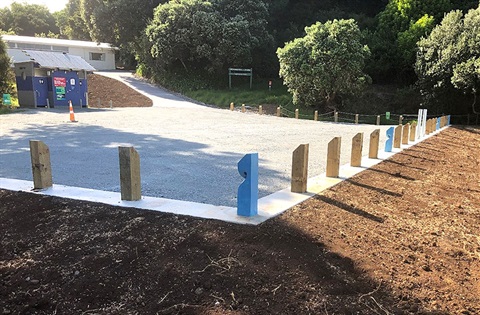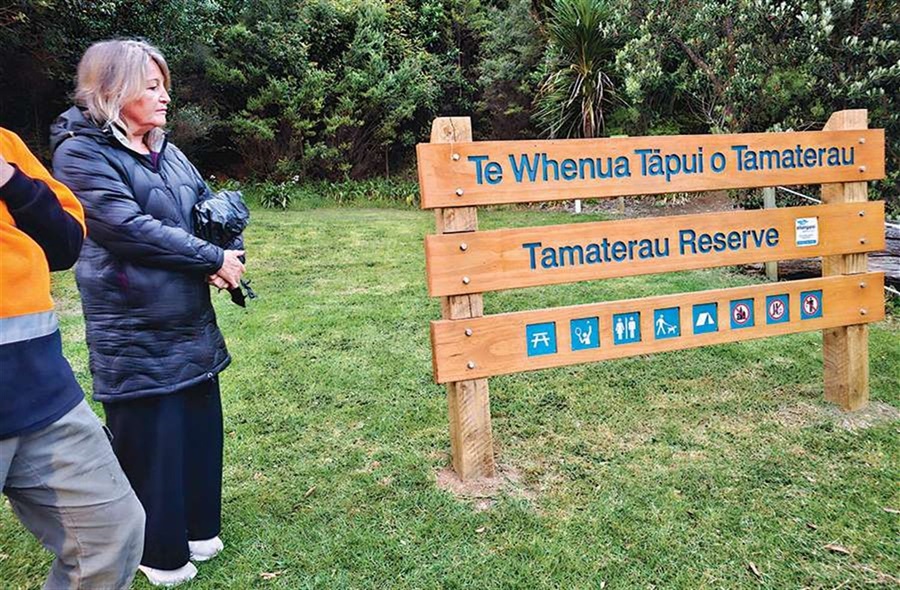Te Whenua Tāpui o Tamaterau project honours cultural heritage
Published on 04 December 2024

Tamaterau Reserve was previously known as Devonshire Park, named after local teacher and botanist Mr Charlie Devonshire.
However, this name did not reflect the historical significance of the land to local hapū, and a project that began in 2020 as a simple upgrade to the reserve carpark (funded by the Tourism Infrastructure Fund) became a much deeper and more meaningful undertaking, taking four years to reach completion.
In order for iwi / hapū to work alongside Council throughout the various stages of the works, the tribal collective He Manu Kōtuku o Tamaterau Working Group was formed.
Altogether, this project covered a full programme of works, including the pruning of taonga trees, foreshore midden site protection, pull-in bay work, bus-shelter upgrade (featuring student artwork from Parua Bay School), carpark enhancement with pou and bollards, stream clean-up, new signage and relocation of Mr Devonshire’s plaque alongside a dedicated bench seat at Tamaterau Hall.
The reserve itself was also renamed to Te Whenua Tāpui o Tamaterau, Tamaterau Reserve.
Personal connection – June Pitman

June Pitman attends the blessing of Te Whenua Tāpui o Tamaterau on Wednesday 6 November 2024.
Historically, this area was a tauranga waka (waka landing and departure point), a mara kai (food cultivation site), and a summer place for pre- and post-colonial Māori, who lived and worked here, and harvested and accessed their traditional kaimoana beds and fishing grounds.
I am predominantly of Te Tāwera o Ngāti Pūkenga, Te Parawhau ki Patuharakeke, Ngāti Maniapoto and Ngāpuhi nui tonu descent. I was born, raised, and have returned home to maintain ahikaaroa on our ancestral land at Tamaterau, Whangārei Heads.
Tamaterau is my tūrangawaewae, my place to stand. Our ancestral land was gifted to Ngāti Pūkenga by the Whangārei tribes in accordance with tikanga. My whānau’s presence in this place stretches back five generations from myself to my great-great-Grandfather Wikitoria Temoananui. His granddaughter, Tiria Parata, married Tom Pitman of Patuharakeke. They raised 18 tamariki, and three mokopuna here at Tamaterau, myself being the youngest.
It is an honour and a privilege to maintain ahikaa and practice kaitiakitanga on behalf of my whānau, Te Tāwera o Ngāti Pūkenga ki Pakikaikutu, and the tribes of Whangārei who gifted the whenua. I’m sure all Ngāti Pūkenga whānau, who have continually occupied this whenua, feel the same way.
In 2020, I was informed that Whangarei District Council had entered discussions with local iwi / hapū regarding the Tamaterau carpark upgrade. The proposed removal of significant taonga puriri trees, which were in poor condition, and the excavation of the main carpark area, a site of cultural heritage, were major concerns.
Historically, this area was a tauranga waka (waka landing and departure point), a mara kai (food cultivation site), and a summer place for pre- and post-colonial Māori, who lived and worked here, and harvested and accessed their traditional kaimoana beds and fishing grounds.
During a meeting with Council, it was revealed that a Cultural Impact Assessment (CIA) report had been delayed due to Covid-19. After discussions, I agreed to lead the project, contacting key iwi / hapū members to gather input and feedback for the CIA report.
With support from those familiar with the Resource Management Act process, several hui were held from October 2020 to March 2021. The final hui led to the formation of He Manu Kōtuku o Tamaterau Working Group to collaborate with Council, completing the works in October 2024.
Numerous people contributed to this project in some way. I'd like to acknowledge Nicki Wakefield, who provided extensive technical knowledge and support to the CIA report, Huhana Lyndon for helping raise awareness and bring the tribal collective together, sharing her knowledge and guiding us through the CIA process, our kaumātua Hori Parata, Ray Haora and Winiwini Kingi (Ngāti Kahu o Torongare) for their guidance and support, Riki Solomon, Te Kaurinui Parata and Mark Scott (Ngāti Pūkenga ki Pakikaikutu) for their contributions, both visually and historically, the students of Parua Bay School, and all who attended hui and dawn blessings along the way.
The Tamaterau Reserve upgrade was a powerful project. It honoured the cultural heritage of the land, addressed health and safety concerns, and provided a platform for sharing the history of the location with visitors.
This project culminated in a dawn blessing ceremony to honour the reinstatement of its Māori name, marking the beginning of a broader effort to bring back knowledge and exposure to the history of Tamaterau for visitors and locals, fostering a deeper understanding and appreciation of the area’s cultural significance.
This article was included in the November 2024 edition of Huaki:
Huaki – November 2024 (issuu.com)
Whangarei District Council contributes a page to the Huaki publication each month. Huaki spotlights Māori excellence, celebrating achievements and culture.